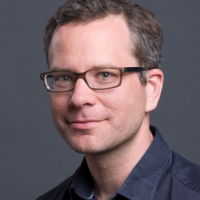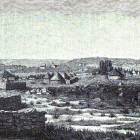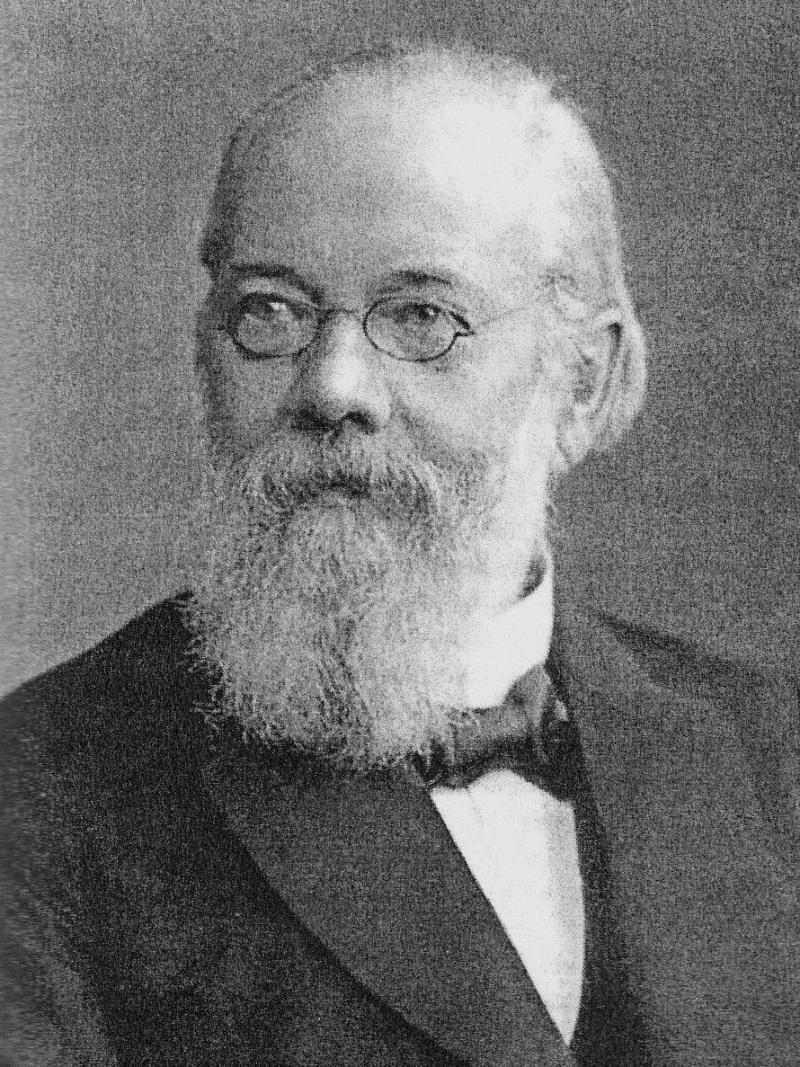
Alexander Merensky (1837–1918)
Alexander Merensky (1837–1918)
Unknown photographer, c. 1910.
Accessed via Wikimedia. Click here to view source.
 This work is licensed under a Creative Commons Public Domain Mark 1.0 License.
This work is licensed under a Creative Commons Public Domain Mark 1.0 License.
The Berlin missionary Alexander Merensky created the missionary village Botshabelo in the southern African Transvaal region together with several Africans in 1865. He later published descriptions of this new village that show some basic transformations of the local Highveld landscape and alterations of biodiversity, as can be found in other missionary enterprises. Negotiating with the newly settled residents, the land was cleared, infrastructure and buildings constructed, foreign plants and animals introduced, and work processes reorganized in a way consistent with the ideals of a Christian society.
We find the account of the founding of the Botshabelo missionary settlement in 1865 in Merensky’s “My Missionary Life in Transvaal” (1888 [1996]). Located between “rocky and swampy areas,” the missionary and the Bapedi and Bakopa people, who had been displaced from their previous villages, carried out the works. Stones and pieces of rock had to be carried, dragged, and even blasted away. The clearing of the land for agriculture reshaped the landscape and structured the multiethnic society of the village. In the beginning, the villagers worked the soil with hoes, and later also with plows to cultivate corn.

Map pinpointing Botshabelo, 1866.
Map pinpointing Botshabelo, 1866.
Courtesy of the Hoffmann Collection of Cultural Knowledge, Humboldt-Universität zu Berlin.
Unknown creator, 1866. The map has been cropped.
Click here to view source.
 This work is licensed under a Creative Commons Attribution 4.0 International License.
This work is licensed under a Creative Commons Attribution 4.0 International License.
Despite the poor conditions, agriculture was the first and often the most important branch of Botshabelo’s mission economy. As in any village in the region, it satisfied the basic requirements of preventing famine and binding inhabitants to the place of the missionary settlement. Merensky described how hard it was at the beginning for the female workers to make furrows in the hard and stony soil for sowing. The inhabitants had to live from hunting gnus and zebras, and gathering wild tree fruits. From the second year on, when the first crops were harvested, they additionally planted peach, quince, pomegranate, and fig trees, using seedlings Merensky obtained from the Boers. The neophyte trees needed to be cut every early spring and properly irrigated so that they would sprout and continue to grow. Merensky, like other missionaries, used agriculture for two objectives: First, agriculture gave prestige to a mission village and the missionary. Second, missions gave people personal access to land, so the settlers remained in the village and thus could be reached by Merensky.
The maps of the village from 1866 and 1882 show how the various agricultural lands were used, distributed, and attributed to groups of inhabitants. The different field crops and plant species, paths, routes, bridges, and irrigation ditches, are recognizable. Agriculture was a part of the missionary work, as described by Alexander Merensky, an effort that intensified the transformation of the landscape and the introduction of new species.
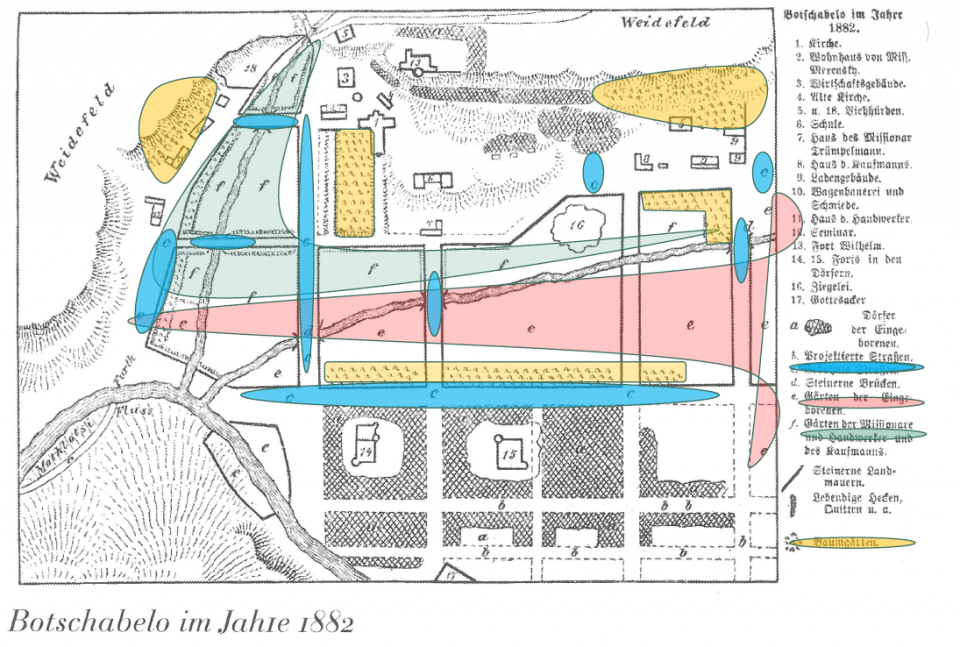
Map indicating the different land uses, buildings, and construction works in Botshabelo, 1882.
Map indicating the different land uses, buildings, and construction works in Botshabelo, 1882.
Map published in Alexander Merensky, Erinnerungen aus dem Missionsleben in Transvaal (Südafrika) 1859 bis 1882, edited by Ulrich van der Heyden (Berlin: Edition Ost, 1996): 248.
 This work is licensed under a Creative Commons Public Domain Mark 1.0 License.
This work is licensed under a Creative Commons Public Domain Mark 1.0 License.
In an earlier text, “Kenntniß über Afrika” (Knowledge about Africa) from 1875, Merensky also dealt with agriculture and the warm climate in a more comparative regional perspective. He mentioned rainy years, which could be disastrous for agriculture. Among the native crops Merensky described were millet and corn. Corn grew better in the wetter areas, while millet flourished in the drier zones. In addition, beans, pumpkin, ground beans, watermelons, and “a kind of sugar cane” were the traditional indigenous crops. Wheat and wine had been introduced by Boers and British settlers, especially in the drier Cape Colony, but prospered less well in the humid climate of Transvaal. Barley and oats also grew on these extremely productive irrigation fields. In the higher areas of Highveld grew “several introduced fruit trees. Furthermore, willows and eucalyptus were introduced as relatively fast-growing tree species to provide shade and firewood” (Merensky, “Kenntniß,” 11–16). Merensky had gained this comparative knowledge from his earlier experiences and his travels in southern Africa.
Furthermore, the Berlin missionary reported on indigenous and imported cattle breeds. Zulu cattle proved suitable as draft animals but gave hardly any milk, in contrast to the cattle that were imported by the English and the Dutch. However, these breeds demanded lusher pastures than the African animals, and brought with them diseases such as lung disease, which quickly spread among the native animals. Merino sheep and Angora goats were also brought in, both of which were of great economic importance for the settlers (Merensky, “Kenntniß,” 26–27).
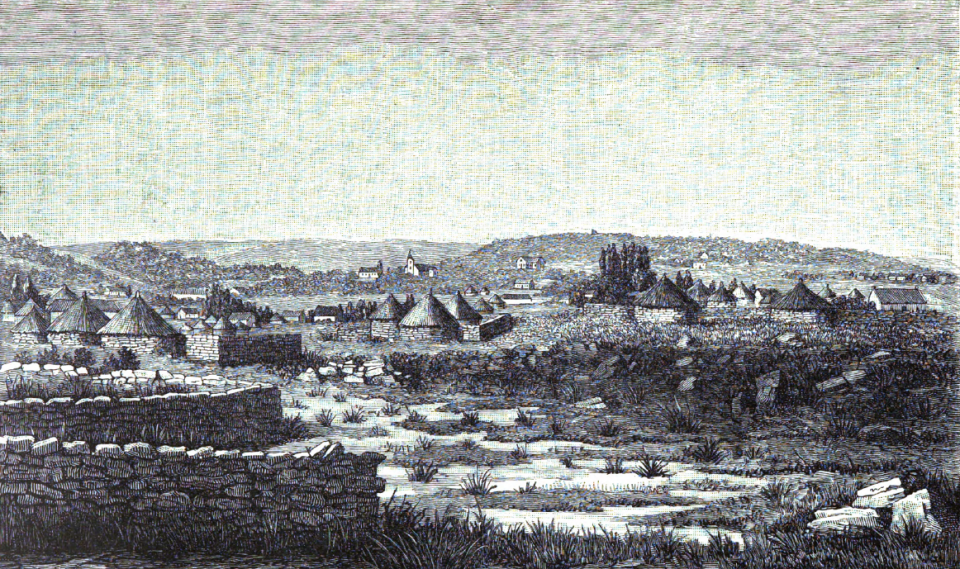
This illustration of Botshabelo, made some time after 1882, depicts houses, fields, and walls erected by the inhabitants.
This illustration of Botshabelo, made some time after 1882, depicts houses, fields, and walls erected by the inhabitants.
Unknown illustrator, n.d.
Originally published in Alexander Merensky, Erinnerungen aus dem Missionsleben in Südost-Afrika, Transvaal, 1859–1882 (Bielefeld: Velhagen & Klasing, 1888).
 This work is licensed under a Creative Commons Public Domain Mark 1.0 License.
This work is licensed under a Creative Commons Public Domain Mark 1.0 License.
Merensky’s descriptions show retrospectively the transformation of the habitat of missionary villages, and especially of Botshabelo during the first twenty years after its foundation. The arrangement of the different “gardens” depicts a social and spatial arrangement of the village, in the interest of the mission, into zones that were assigned to the missionary and those that were assigned to the other inhabitants. The land was made suitable for agriculture. Watercourses were diverted, fields were irrigated and roads were built. Plants and animals from the region were resettled and species from Europe were introduced to Botshabelo. This small mission village (among many hundreds worldwide) thus shows the immense power of such communities in the global colonial ecological transformation.
How to cite
Wendt, Helge. “Missionizing and Transforming the Land: Alexander Merensky in Botshabelo.” Environment & Society Portal, Arcadia (Summer 2021), no. 22. Rachel Carson Center for Environment and Society. doi:10.5282/rcc/9317.
ISSN 2199-3408
Environment & Society Portal, Arcadia
 This work is licensed under a Creative Commons Attribution 4.0 International License.
This work is licensed under a Creative Commons Attribution 4.0 International License.
2021 Helge Wendt
This refers only to the text and does not include any image rights.
Please click on the images to view their individual rights status.
- Comaroff, Jean, and John L. Comaroff. Of Revelation and Revolution. 2 Vols. Chicago: The University of Chicago Press, 1991–1997.
- Jacobs, Nancy J. Environment, Power, and Injustice: A South African History. Cambridge: Cambridge University Press, 2003,
- Merensky, Alexander. Beiträge zur Kenntniß Süd-Afrikas, geographischen, ethnographischen und historischen Inhalts. Berlin: Wiegandt & Grieben, 1875.
- Merensky, Alexander. Erinnerungen aus dem Missionsleben in Transvaal (Südafrika) 1859 bis 1882. First published 1899. Edited by Ulrich van der Heyden. Berlin: Edition Ost, 1996.
- Schultze, Andrea. „In Gottes Namen Hütten bauen“. Kirchlicher Landbesitz in Südafrika: die Berliner Mission und die Evangelisch-Lutherische Kirche Südafrikas zwischen 1834 und 2005. Stuttgart: Franz Steiner, 2005.
- Shanguhyia, Martin S., and Toyin Falola, eds. The Palgrave Handbook of African Colonial and Postcolonial History. New York: Palgrave Macmillan, 2018.
- Swanepoel, Natalie. “Not Built in a Day: The Evolving Landscape of the Botshabelo Mission Station, South Africa, 1865–2015.” Journal of Southern African Studies 44, no. 4 (2018): 681–702. doi:10.1080/03057070.2018.1480116.


